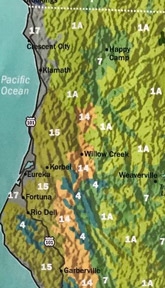
Selecting plants is not a “one-plant-fits-all” approach. Trees, shrubs, plants, vegetables, etc., all have their own climate requirement to grow and produce at their best. Knowing your planting zone is the first key element in selecting your landscape plants and trees, knowing when to plant your vegetable crops and knowing if certain fruit trees and berries will be successful in your area.
The USDA Cold hardiness zones are based on winter minimum temperatures. The AHS (American Horticultural Society) heat zone system is based on average number of days above 86 degrees F. Since these two systems are limited, the best and most reliable system is the Sunset Zone.
We recommend using the Sunset zone system. This system bases its climate zones consisting of many factors: cold, heat, humidity, wind, proximity to the Pacific Ocean, snow cover, and the length of the growing system.
The Humboldt and Del Norte Counties consists of 6 Sunset Zones. Zone 17 is the maritime zone for both counties. Zone 1a is the Costal Range Mountains for both counties. Zone 15 is Humboldt's costal zone, 14 is the interior zone and transitional zones are 4 and 7. Del Norte's transitional zone is 7. To determine your zone visit our Website to find your location on the Sunset Map.
Most all landscapes and gardens have microclimates. These are areas in your gardens that are influenced by various factors: i.e. exposure to wind, structure walls, sloping ground, dry banks, eaves and overhead structures and trees.
Shade trees and overhead structures will provide planting areas for shade loving plants. During a frosty evening, this area will be a few degrees warmer than the air over the open ground.
Masonry and stucco south and west walls soak up solar energy during the day and then releases it at night. In our counties cooler summer days, it will help to provide the warmth that heat loving vegetables require during the day and the evening.
North walls get little direct sun. This is a perfect location for woodland plants like ferns.
East walls generally can get up to half a day of sun and is less intense than a west facing wall. Azaleas and fuchsias generally will be happy.
Eaves will provide frost protection for delicate flowers.
Sloping grounds make a perfect location to grow citrus as the air flow is warmer than the air on hilltops or in the valleys below.
Drought tolerant plants would be the best solutions for planting in dry bank areas.
Cold air pockets lay in low-lying areas. This is a benefit for tulips which needs that extra chill to encourage bloom. These cold pockets are also good locations for certain fruit trees and berries which require cold periods for production of fruit.
Get to know your garden and plan your selection of plants and plant site location. Use microclimates to your advantage to be successful with your vegetable gardens and your landscape.
Source: The Western Sunset Zone 2017 Third Edition